Photo: Louise Houmøller Olesen
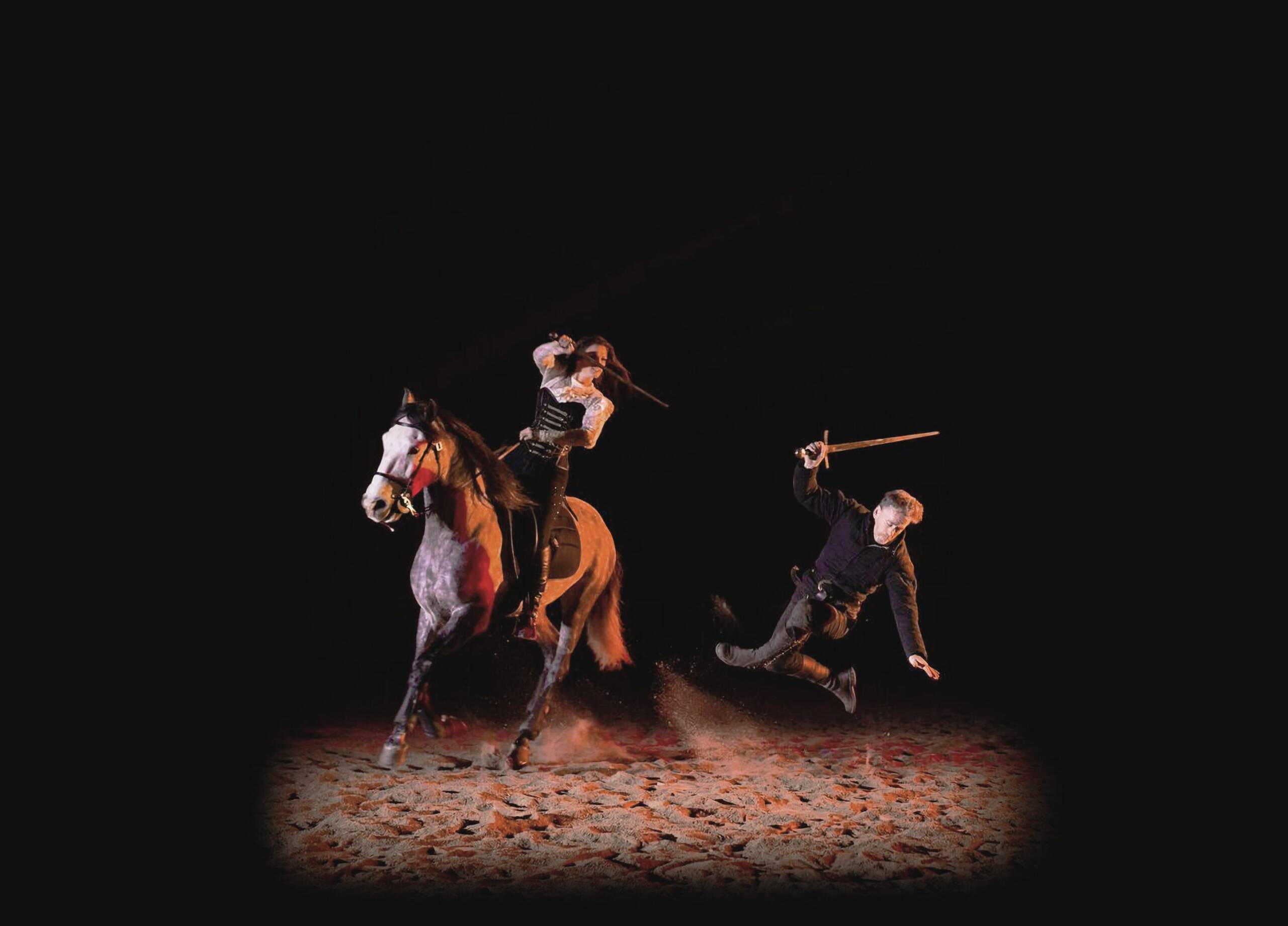

fighting, explosions, chases, and escapes all look great on film. But when there are horses involved, many horse people are struck by the thought: "Is it safe for the horse?". But according to Ally McClelland, there is nothing to fear. Horse welfare is a high priority, and the experienced horse trainer makes many considerations about how to get a stunt horse that both looks good on the white canvas, but also thrives in the role of a stunt horse.
The horse's temper is the most important thing
In principle, all horses can become stunt horses. It just requires that it has the right mindset and temperament.
"The horse's temper is the most important thing. It must want to work,” Ally, who has had many horses in his hand, explains. Ally emphasizes that it is necessary for the horse to have a good on / off button.
"It must be possible to pump the horse up to the point where it really shows its strength and movement. But at the same time, it must also be possible to switch it off immediately. This is both for the sake of safety, but also for the well-being of the horse. If it cannot be turned off again, it will get stressed,” Ally tells, and elaborates:
“Stunt horses are a bit like sports cars that you can turn on and off. You can turn it on, and then they make a lot of noise and are wild, but as soon as you turn it off, it is a car like any other car.”
It is often Iberian horses, such as Andalusians and Lusitanos, that are used as stunt horses because they have just the right attitude and the right mindset.
“The Iberian horses are bred to be hardworking, confident and brave. In addition, they are beautiful to look at, so they are ideal for movies,” Ally says.
"If I ask a Lusitano, for instance, to go forward in a place that can be a little scary for it, it does so, even if it may initially be hesitant. They trust their people a lot, and therefore they are relatively easy to train.”
It is important that the horses are brave when making films. This is especially true of action movies, which include many props, and the scenes are often include smoke, fire, and loud noises.
The training must be fun
Just as some horses clearly love to jump, do dressage or ride in the woods, so it is also quite clear to Ally that some horses love to do tricks and stunts.
"My own horse gets really happy when I find props that are used for fight scenes. It can for example, be swords and lances. Then he is completely up to speed, and he cannot wait.” says Ally, laughing.
For Ally, it is important that training should be a game and that the horse should want to work and collaborate. It is all about that relationship and the teamwork between horse and human. But not everyone shares his training philosophy.
"There will always be some black sheep in the industry who use punishment as a training method. They are violent with the whip and do not care if the horse actually enjoys working,” Ally says.
“If you make training a breeze, the horse will also want to work and do his best. If training instead becomes a sour duty and is affected by fear, you will never get a good result.”
Rule number 1 is always safety
Over the years, the approach to safety has changed - not least among horses.
“Rule number 1 is always safety. Safety for the actors, safety for the camera people, directors and so on. But not least, it is safety in relation to the horses,” Ally says.
Safety is also the main reason why Ally never makes violent fall scenes where the horse has to fall hard to the ground. It cannot be done safely and without the risk of harming the horse.
"If I get called up and ordered to make a violent horse fall, I simply say no. I do not do that,” he says. "I would never ask a horse to fall 6-7 times in a row to get 'the perfect shot' from different angles."
To Ally, there is a big difference between asking a horse to lie down and getting it to throw itself down.
“Even if you do a lot to make it comfortable for the horse, for example by using specially designed saddles that are completely soft, or making the ground as soft as possible, you cannot avoid it becoming uncomfortable and harmful for the horse, if it has to throw itself down at high speed,” Ally explains, and continues: “It is unnatural for the horse. A horse in the wild would never throw itself to the ground.”
Besides it being harmful to the horse, you also expose the rider to a great risk.
"It is also unsafe for the rider because the horse can easily roll over the rider or the rider gets stuck under the horse."
So there are several things that speak against doing these stunts. When we still see them in movies, a "dummy" is often used, A dummy is a fake horse which looks very realistic, and is subsequently edited on the computer.
"Now that we have such good computer technology as we have today, there is simply no reason to do these stunts in real life," Ally says.
Horses are always first priority
Ally emphasizes that horse welfare is a very high priority, both when making films and live-action events such as theater. Sometimes the well-being of horses is even given higher priority than human beings:
“The horses always get their breaks. They are allowed to relax; they get plenty of food and water. The rest of us do not necessarily take breaks. We can get a sandwich on the road, but otherwise we work hard for 12 to 14 hours,” Ally says, smiling.
Horse welfare is also one of the reasons why you always try to have two horses that can do the same thing.
“If you need a white horse that can rear, then we want two white horses that can rear. That way we can switch if one is not at the top, needs a break or the like,” Ally explains. "If I am told that 20 horses are needed, I always have 25 horses with me, so there is always one or more backups," he explains.
The desire for a high degree of horse welfare has also been of crucial importance to several stuntmen and riders. Because even though 99% of the stuntmen and riders who are riding the horses in various scenes are skilled and competent riders who do what Ally asks them to do, it cannot be avoided that once in a while there are some who does not share Ally's desire for happy horses. And it has had consequences:
"I have seen people, who have been fired from a film production because they did not treat the horse properly. I have also done it myself sometimes, if I have worked with some stuntmen, who have not had the same set of values as myself and have not treated the horse properly. Then I also fired them on the spot. The horse's well-being comes before everything else, and everyone must respect that,” Ally tells.
Foto: Futura Tittaferrante
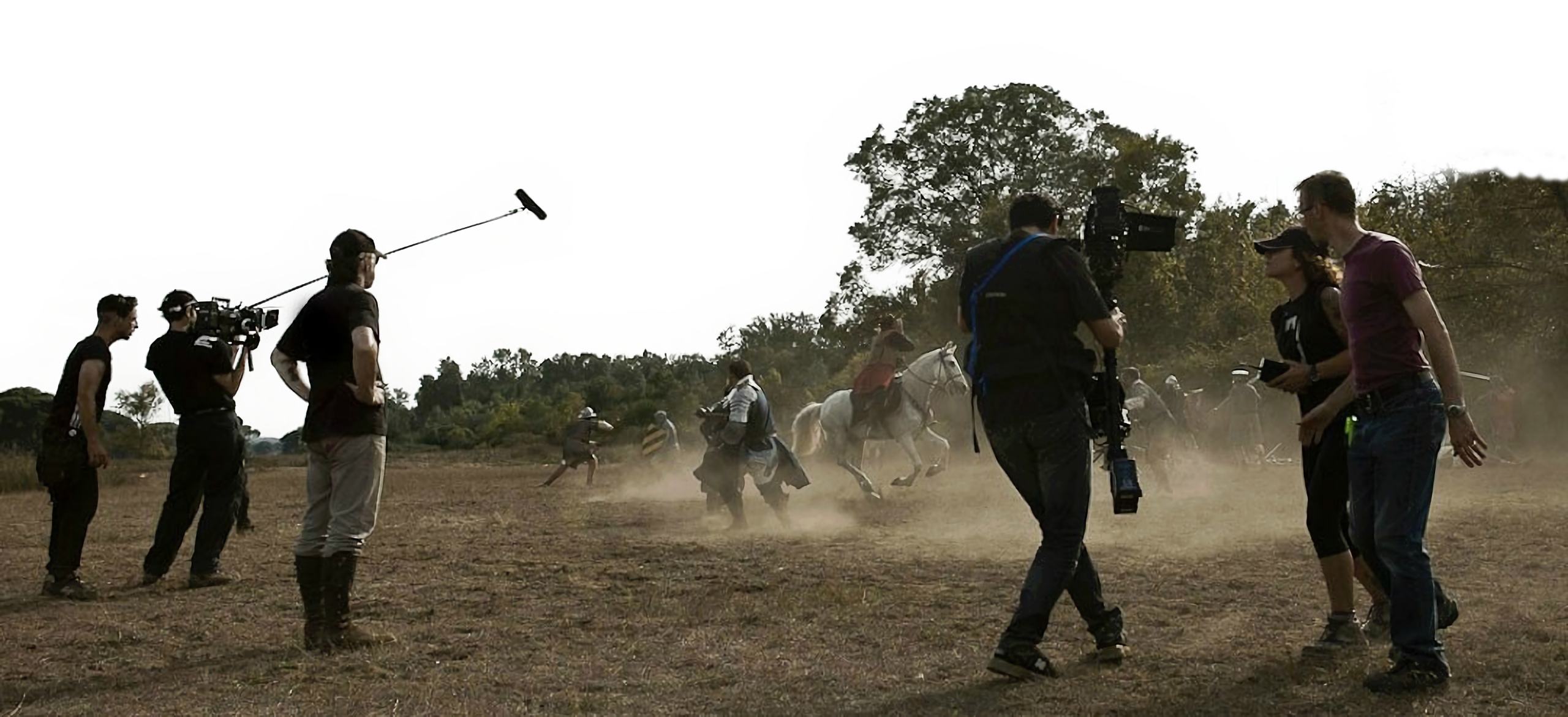
Advertisement



The actors must be able to handle the horse in all situations
Some actors are completely green, when it comes to riding and horses. If they have no experience at all, then they will usually come to a riding course before the actual recordings, so they have a feel for the horses and have the basics in place.
There are two different kinds of stunt horses. There are the stunt horses that the actors ride that are usually much calmer, and then there are the real stunt horses that can be compared to a Ferrari. They require a more experienced rider, and the stuntmen ride them.
Some actors are very open and eager to learn, and they listen to the instructions they are given. Others are not quite as easy to instruct in riding and handling horses.
"I'm not afraid to say no to an actor, if they cannot handle the horse, even if they themselves think they have good control of it. Then we use a stand-in instead.”
"It's all about safety. It always comes first. So, if it's not safe to let the actor ride himself, then we have to get someone else to do it.”
Ally also makes several live events, for example he has participated in the Royal Theatre's production of Robin Hood, which was shown in Dyrehaven, north of Copenhagen, Denmark. Here he emphasizes that it is particularly important that the actors are aware of their abilities as riders.
"When we go live, as we do at a theater, it is absolutely essential that the actors can handle the horses. When making films, you can retake the scene over and over again, but on a stage where there are 3,500 spectators who have paid for tickets and expect to see a good show, it is not possible to start over. The show must go on, as they say, and this also applies, if the horse suddenly decides not to follow the script. Horses are not machines, they have their own minds and feelings, so occasionally we have to improvise in a live show, and that takes a good rider with a calm head to be able to do that.”
The horses can easily get more livelier, when there is an audience sitting and clapping, and the whole situation is more tense than on a film set because the scene cannot be taken over many times. It places greater demands on the actor.
The basic riding skills must be in place
When Ally has to teach an actor to ride, they learn from the ground up, and not just what needs to be used for the specific scene. If they can already ride a little, then they work on from that, but it is important that all actors can master the basic riding technique.
"Again, it's all about safety. The actor must be able to control the horse, and they cannot do so if they have only just learned to gallop and swing with a sword at the same time. They need to know what to do if something goes wrong. How to stop a runaway horse, how to get a nervous horse to relax, how to sit, what to do with their hands and legs. They get a very comprehensive training, because it is simply necessary for it to be safe to make films and theatre with horses.”
Ally is of the opinion that actors are generally easier to to teach how to ride, because they are used to listening well and do what they are asked to do. They also want to look good on camera, so they are focused on the task at hand.
"They also have to be good at riding because it has to look real. If it does not look real and believable, then the audience does not think they have seen a good movie. Then they see through the actor.”
"If the actor plays a king, a knight or a cowboy, then they also have to look like they are good at riding. Otherwise, it all falls to the ground because there is no connection between the actor's role and the actor's actions.”
The whole film industry is characterized by a lot of directness, and therefore it is not a bad thing that Ally is very direct when he teaches the actors. There is a consensus that you does not waste each other's time, and therefore the criticism is not wrapped up. That, Ally thinks, makes it a lot easier to teach an actor to ride, and when you do not have much time to work with, then it has to be easy and effective
When the film is to be made
When a film is to be made, the producers contact Ally and order the horses to be used. There are both wishes for colors, breeds and sizes, but two very specific horses must almost always be used – a white and a black one.
"I almost always have to get both a white and a black horse who can do the wild tricks. A white horse for the hero and a black for the villain,” Ally says.
When Ally has got the horses covered, including how they are transported to the location, how the stabling takes place and whether there is control of the feed, he talks to the instructor and the cameramen. Here, storyboards are an important tool because it tells Ally exactly what stunt to perform, how it is filmed and where everyone else will be.both actors and cameramen.
"Once it has been decided how a scene should take place and be filmed, it will not be changed. Then you do not suddenly decide to move two cameras at the last minute. This is especially important when there are horses in the scene. If you first start to change a lot, then it can be dangerous and both animals and humans can be harmed,” Ally explains.
When Ally is about to make a movie or a live action event, he always does risk assessments. And these can easily become 12 – 15 pages long, because it assesses everything that could possibly go wrong, but also assessments of how it can be avoided.
“We go into great detail and assess the situations based on the individual horse when we make the risk assessments. That way, we try to solve the problems before they even occur,” Ally explains. The risk assessments, together with the storyboards and plenty of rehearsals, are tools that will make it safe to have horses in films.
"Everything is very structured, and it has to be. Everyone must know their role and tasks, so we are sure that the filming can be done as smoothly as possible - both for humans and animals."
.
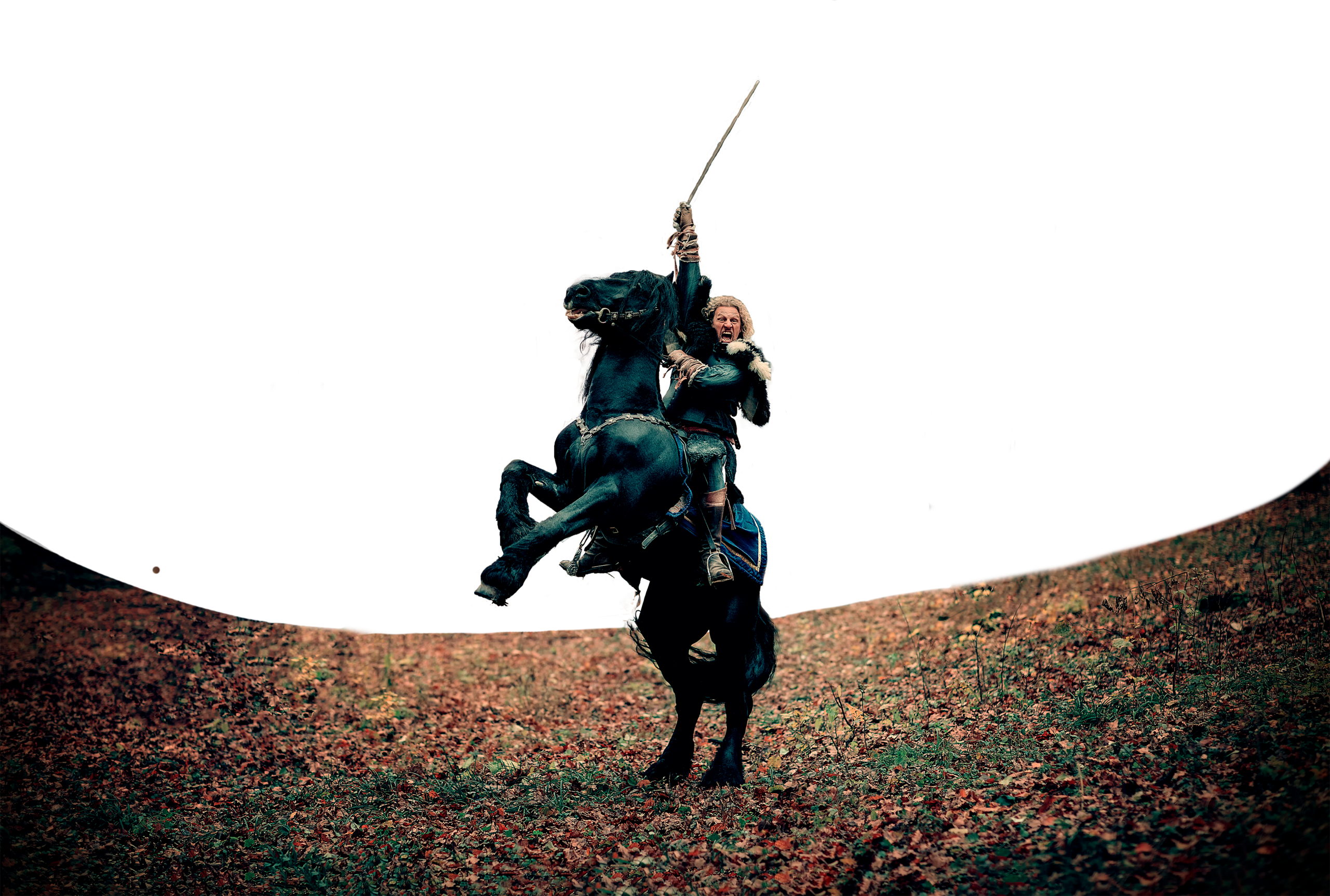
Ally McClelland has more than 25 years of experience in stunts and horse training for film and theatre.
He has worked with The Devil’s Horsemen and Atkinson Action Horses, among others.
Ally McClelland has both worked on major Hollywood films and countless live-action events, including the Royal Danish Theatre’s 2013 production of Robin Hood in Dyrehaven, where he was the horse stunt coordinator and also one of the actors riding in the show.
Photo: Signe Rosenberg

Actor or stand-in?
When the actual stunts are to be done, it is very rarely the actors who do it. A stand-in is often used here.
"Even though the actors learn to ride, and some of them can be very skilled, there is always a risk when working with horses and that risk should be taken by the stunt performers because if an actor gets hurt then that will cost the production delays and money. Nobody wants to see anyone get hurt, but in the stunt profession we know the risk and accept it. It’s then our job to keep everyone including horses as safe as possible but still deliver an amazing scene," says Ally.
An actor who, however, does several of his stunts himself, is Russell Crowe. He starred in the 2010 film Robin Hood, and Ally was part of the team for the action scenes.
"Russell Crowe is a very good rider, and he also has a ranch with horses. He did some of the riding stunts himself in the Robin Hood film,” Ally says. However, Ally adds that when Crowe himself did his stunts, space was also made for it - literally.
“If, for example, he had to ride fast between two men on the ground, then a stuntman might only have a meter or less of space to do it. When Russell Crowe did that, he got maybe two to three times as much space. Then the cameras are placed so that you can actually not see that he is not riding very close,” Ally explains. These extra safety precautions are due, among other things, to the fact that the production simply cannot afford to have an actor like Russell injured or badly hurt
There is a very big trust relationship between actor, horse, and stuntman. Ally has himself appeared in several films, including Robin Hood, where he has, for example, stood on the ground in a fight scene, while the hero has ridden against him at full gallop.
“It is very important that I trust the actor on the horse and that the horse is trustworthy. And then they must also trust me, and trust that I will do as we have agreed. Otherwise, it will quickly become very dangerous.”
The importance of well-trained horses and riders
Although Ally enjoys spending many hours training horses (and riders), it's not just for fun. A poorly trained horse or rider can cost the film company a lot of money and it’s dangerous.
"Every time you have to remake a scene, it costs money. So, if the preliminary work with both horse and rider is not proper, then the costs are expensive," says Ally, and elaborates: "In addition, there is also a risk of having unhappy colleagues, both actors and the people behind the cameras. And if there is something that is not good horse welfare, then it is impatient and angry people."
The good training and the high safety among both horses and riders are just some of the reasons why Ally does not see anything negative in using live animals in movies.
"I have no worries when I see horses appear in films, because I know that in 99.9% of the cases, they have had a good time, and even better than some of the actors. Animal welfare is so high on the priority list, and on almost all productions there will be an animal welfare officer on set, regardless of whether it is a large or small film, the conditions have been in order, and everything else being equal, it must be the most important thing,” he concludes.
Photo: Louise Houmøller Olesen
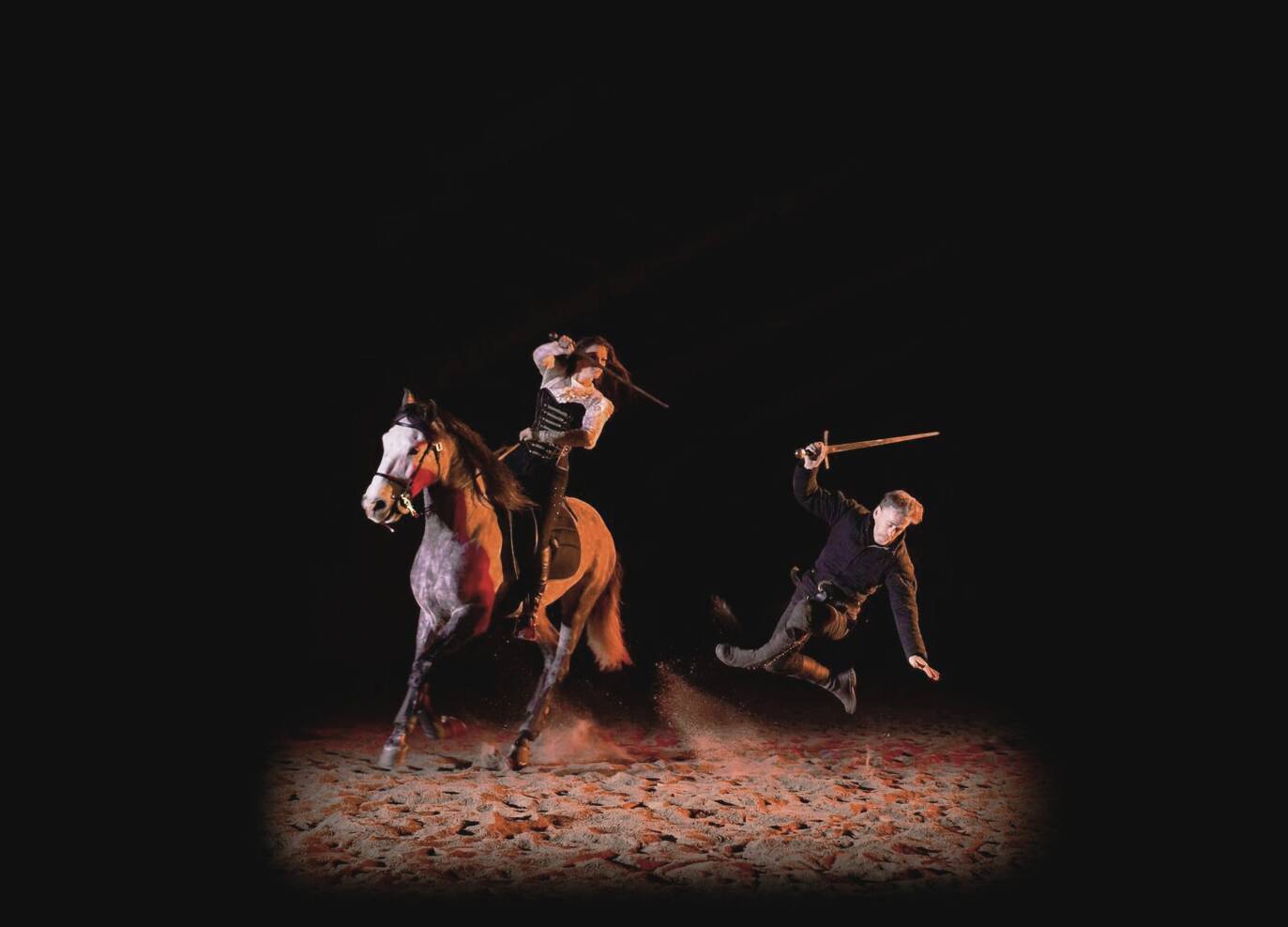

Foto: Futura Tittaferrante
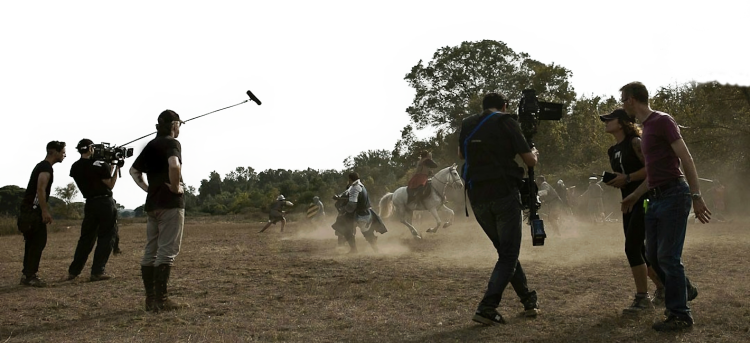
fighting, explosions, chases, and escapes all look great on film. But when there are horses involved, many horse people are struck by the thought: "Is it safe for the horse?". But according to Ally McClelland, there is nothing to fear. Horse welfare is a high priority, and the experienced horse trainer makes many considerations about how to get a stunt horse that both looks good on the white canvas, but also thrives in the role of a stunt horse.
The horse's temper is the most important thing
In principle, all horses can become stunt horses. It just requires that it has the right mindset and temperament.
"The horse's temper is the most important thing. It must want to work,” Ally, who has had many horses in his hand, explains. Ally emphasizes that it is necessary for the horse to have a good on / off button.
"It must be possible to pump the horse up to the point where it really shows its strength and movement. But at the same time, it must also be possible to switch it off immediately. This is both for the sake of safety, but also for the well-being of the horse. If it cannot be turned off again, it will get stressed,” Ally tells, and elaborates:
“Stunt horses are a bit like sports cars that you can turn on and off. You can turn it on, and then they make a lot of noise and are wild, but as soon as you turn it off, it is a car like any other car.”
It is often Iberian horses, such as Andalusians and Lusitanos, that are used as stunt horses because they have just the right attitude and the right mindset.
“The Iberian horses are bred to be hardworking, confident and brave. In addition, they are beautiful to look at, so they are ideal for movies,” Ally says.
"If I ask a Lusitano, for instance, to go forward in a place that can be a little scary for it, it does so, even if it may initially be hesitant. They trust their people a lot, and therefore they are relatively easy to train.”
It is important that the horses are brave when making films. This is especially true of action movies, which include many props, and the scenes are often include smoke, fire, and loud noises.
The training must be fun
Just as some horses clearly love to jump, do dressage or ride in the woods, so it is also quite clear to Ally that some horses love to do tricks and stunts.
"My own horse gets really happy when I find props that are used for fight scenes. It can for example, be swords and lances. Then he is completely up to speed, and he cannot wait.” says Ally, laughing.
For Ally, it is important that training should be a game and that the horse should want to work and collaborate. It is all about that relationship and the teamwork between horse and human. But not everyone shares his training philosophy.
"There will always be some black sheep in the industry who use punishment as a training method. They are violent with the whip and do not care if the horse actually enjoys working,” Ally says.
“If you make training a breeze, the horse will also want to work and do his best. If training instead becomes a sour duty and is affected by fear, you will never get a good result.”
Rule number 1 is always safety
Over the years, the approach to safety has changed - not least among horses.
“Rule number 1 is always safety. Safety for the actors, safety for the camera people, directors and so on. But not least, it is safety in relation to the horses,” Ally says.
Safety is also the main reason why Ally never makes violent fall scenes where the horse has to fall hard to the ground. It cannot be done safely and without the risk of harming the horse.
"If I get called up and ordered to make a violent horse fall, I simply say no. I do not do that,” he says. "I would never ask a horse to fall 6-7 times in a row to get 'the perfect shot' from different angles."
To Ally, there is a big difference between asking a horse to lie down and getting it to throw itself down.
“Even if you do a lot to make it comfortable for the horse, for example by using specially designed saddles that are completely soft, or making the ground as soft as possible, you cannot avoid it becoming uncomfortable and harmful for the horse, if it has to throw itself down at high speed,” Ally explains, and continues: “It is unnatural for the horse. A horse in the wild would never throw itself to the ground.”
Besides it being harmful to the horse, you also expose the rider to a great risk.
"It is also unsafe for the rider because the horse can easily roll over the rider or the rider gets stuck under the horse."
So there are several things that speak against doing these stunts. When we still see them in movies, a "dummy" is often used, A dummy is a fake horse which looks very realistic, and is subsequently edited on the computer.
"Now that we have such good computer technology as we have today, there is simply no reason to do these stunts in real life," Ally says.
Horses are always first priority
Ally emphasizes that horse welfare is a very high priority, both when making films and live-action events such as theater. Sometimes the well-being of horses is even given higher priority than human beings:
“The horses always get their breaks. They are allowed to relax; they get plenty of food and water. The rest of us do not necessarily take breaks. We can get a sandwich on the road, but otherwise we work hard for 12 to 14 hours,” Ally says, smiling.
Horse welfare is also one of the reasons why you always try to have two horses that can do the same thing.
“If you need a white horse that can rear, then we want two white horses that can rear. That way we can switch if one is not at the top, needs a break or the like,” Ally explains. "If I am told that 20 horses are needed, I always have 25 horses with me, so there is always one or more backups," he explains.
The desire for a high degree of horse welfare has also been of crucial importance to several stuntmen and riders. Because even though 99% of the stuntmen and riders who are riding the horses in various scenes are skilled and competent riders who do what Ally asks them to do, it cannot be avoided that once in a while there are some who does not share Ally's desire for happy horses. And it has had consequences:
"I have seen people, who have been fired from a film production because they did not treat the horse properly. I have also done it myself sometimes, if I have worked with some stuntmen, who have not had the same set of values as myself and have not treated the horse properly. Then I also fired them on the spot. The horse's well-being comes before everything else, and everyone must respect that,” Ally tells.
Advertisement



The actors must be able to handle the horse in all situations
Some actors are completely green, when it comes to riding and horses. If they have no experience at all, then they will usually come to a riding course before the actual recordings, so they have a feel for the horses and have the basics in place.
There are two different kinds of stunt horses. There are the stunt horses that the actors ride that are usually much calmer, and then there are the real stunt horses that can be compared to a Ferrari. They require a more experienced rider, and the stuntmen ride them.
Some actors are very open and eager to learn, and they listen to the instructions they are given. Others are not quite as easy to instruct in riding and handling horses.
"I'm not afraid to say no to an actor, if they cannot handle the horse, even if they themselves think they have good control of it. Then we use a stand-in instead.”
"It's all about safety. It always comes first. So, if it's not safe to let the actor ride himself, then we have to get someone else to do it.”
Ally also makes several live events, for example he has participated in the Royal Theatre's production of Robin Hood, which was shown in Dyrehaven, north of Copenhagen, Denmark. Here he emphasizes that it is particularly important that the actors are aware of their abilities as riders.
"When we go live, as we do at a theater, it is absolutely essential that the actors can handle the horses. When making films, you can retake the scene over and over again, but on a stage where there are 3,500 spectators who have paid for tickets and expect to see a good show, it is not possible to start over. The show must go on, as they say, and this also applies, if the horse suddenly decides not to follow the script. Horses are not machines, they have their own minds and feelings, so occasionally we have to improvise in a live show, and that takes a good rider with a calm head to be able to do that.”
The horses can easily get more livelier, when there is an audience sitting and clapping, and the whole situation is more tense than on a film set because the scene cannot be taken over many times. It places greater demands on the actor.
The basic riding skills must be in place
When Ally has to teach an actor to ride, they learn from the ground up, and not just what needs to be used for the specific scene. If they can already ride a little, then they work on from that, but it is important that all actors can master the basic riding technique.
"Again, it's all about safety. The actor must be able to control the horse, and they cannot do so if they have only just learned to gallop and swing with a sword at the same time. They need to know what to do if something goes wrong. How to stop a runaway horse, how to get a nervous horse to relax, how to sit, what to do with their hands and legs. They get a very comprehensive training, because it is simply necessary for it to be safe to make films and theatre with horses.”
Ally is of the opinion that actors are generally easier to to teach how to ride, because they are used to listening well and do what they are asked to do. They also want to look good on camera, so they are focused on the task at hand.
"They also have to be good at riding because it has to look real. If it does not look real and believable, then the audience does not think they have seen a good movie. Then they see through the actor.”
"If the actor plays a king, a knight or a cowboy, then they also have to look like they are good at riding. Otherwise, it all falls to the ground because there is no connection between the actor's role and the actor's actions.”
The whole film industry is characterized by a lot of directness, and therefore it is not a bad thing that Ally is very direct when he teaches the actors. There is a consensus that you does not waste each other's time, and therefore the criticism is not wrapped up. That, Ally thinks, makes it a lot easier to teach an actor to ride, and when you do not have much time to work with, then it has to be easy and effective
When the film is to be made
When a film is to be made, the producers contact Ally and order the horses to be used. There are both wishes for colors, breeds and sizes, but two very specific horses must almost always be used – a white and a black one.
"I almost always have to get both a white and a black horse who can do the wild tricks. A white horse for the hero and a black for the villain,” Ally says.
When Ally has got the horses covered, including how they are transported to the location, how the stabling takes place and whether there is control of the feed, he talks to the instructor and the cameramen. Here, storyboards are an important tool because it tells Ally exactly what stunt to perform, how it is filmed and where everyone else will be.both actors and cameramen.
"Once it has been decided how a scene should take place and be filmed, it will not be changed. Then you do not suddenly decide to move two cameras at the last minute. This is especially important when there are horses in the scene. If you first start to change a lot, then it can be dangerous and both animals and humans can be harmed,” Ally explains.
When Ally is about to make a movie or a live action event, he always does risk assessments. And these can easily become 12 – 15 pages long, because it assesses everything that could possibly go wrong, but also assessments of how it can be avoided.
“We go into great detail and assess the situations based on the individual horse when we make the risk assessments. That way, we try to solve the problems before they even occur,” Ally explains. The risk assessments, together with the storyboards and plenty of rehearsals, are tools that will make it safe to have horses in films.
"Everything is very structured, and it has to be. Everyone must know their role and tasks, so we are sure that the filming can be done as smoothly as possible - both for humans and animals."
.

Photo: Signe Rosenberg
Ally McClelland has more than 25 years of experience in stunts and horse training for film and theatre.
He has worked with The Devil’s Horsemen and Atkinson Action Horses, among others.
Ally McClelland has both worked on major Hollywood films and countless live-action events, including the Royal Danish Theatre’s 2013 production of Robin Hood in Dyrehaven, where he was the horse stunt coordinator and also one of the actors riding in the show.
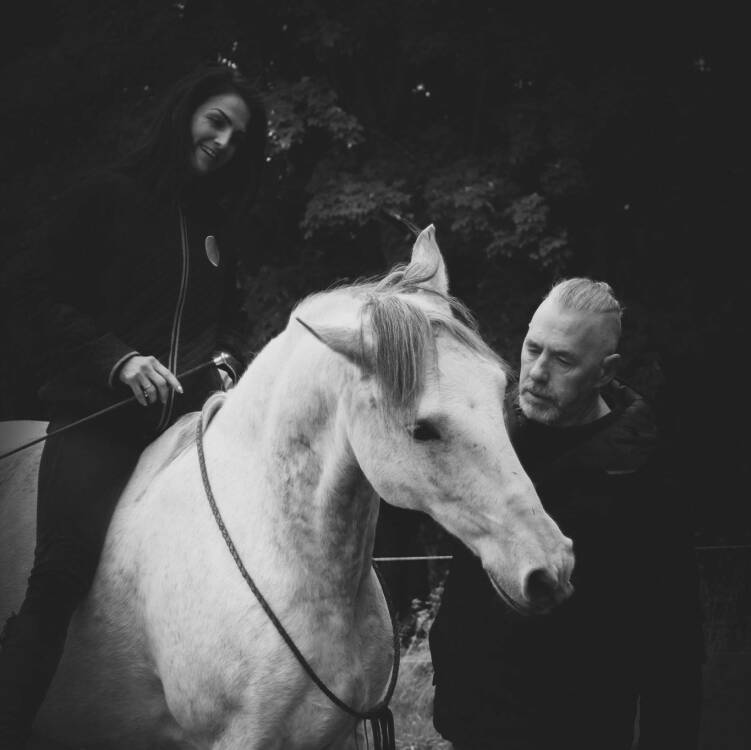
Actor or stand-in?
When the actual stunts are to be done, it is very rarely the actors who do it. A stand-in is often used here.
"Even though the actors learn to ride, and some of them can be very skilled, there is always a risk when working with horses and that risk should be taken by the stunt performers because if an actor gets hurt then that will cost the production delays and money. Nobody wants to see anyone get hurt but in the stunt profession we know the risk and accept it, it’s then our job to keep everyone including horses as safe as possible but still deliver an amazing scene," says Ally.
An actor who, however, does several of his stunts himself, is Russell Crowe. He starred in the 2010 film Robin Hood and Ally was part of the team for the action scenes.
"Russell Crowe is a very good rider, and he also has a ranch with horses. He did some of the riding stunts himself in the Robin Hood film,” Ally says. However, Ally adds that when Crowe himself did his stunts, space was also made for it - literally.
“If, for example, he had to ride fast between two men on the ground, then a stuntman might only have a meter or less of space to do it. When Russell Crowe did that, he got maybe two to three times as much space. Then the cameras are placed so that you can actually not see that he is not riding very close,” Ally explains. These extra safety precautions are due, among other things, to the fact that the production simply cannot afford to have an actor like Russell injured or badly hurt
There is a very big trust relationship between actor, horse, and stuntman. Ally has himself appeared in several films, including Robin Hood, where he has, for example, stood on the ground in a fight scene, while the hero has ridden against him at full gallop.
“It is very important that I trust the actor on the horse and that the horse is trustworthy. And then they must also trust me and trust that I will do as we have agreed. Otherwise, it will quickly become very dangerous.”
The importance of well-trained horses and riders
Although Ally enjoys spending many hours training horses (and riders), it's not just for fun. A poorly trained horse or rider can cost the film company a lot of money and it’s dangerous.
"Every time you have to remake a scene, it costs money. So, if the preliminary work with both horse and rider is not proper, then the costs are expensive, "says Ally, and elaborates: "In addition, there is also a risk of having unhappy colleagues, both actors and the people behind the cameras. And if there is something that is not good horse welfare, then it is impatient and angry people."
The good training and the high safety among both horses and riders are just some of the reasons why Ally does not see anything negative in using live animals in movies.
"I have no worries when I see horses appear in films, because I know that in 99.9% of the cases, they have had a good time, and even better than some of the actors. Animal welfare is so high on the priority list, and on almost all productions there will be an animal welfare officer on set, regardless of whether it is a large or small film, the conditions have been in order, and everything else being equal, it must be the most important thing,” he concludes.